Analysis of Accounting Standards and Regulations: Vicinity VCX
VerifiedAdded on 2021/06/18
|7
|1692
|29
Report
AI Summary
This report provides a comprehensive analysis of the accounting standards and regulations applicable to Vicinity VCX, a real-estate investment trust listed on the ASX. The report delves into the application of AASB 140 for investment properties, focusing on measurement, recognition, and disclosure, and the valuation methods employed by the company, including cost and fair value models. It examines the influence of retail market variations on the company's financial performance, highlighting the impact on rental income, property values, and capital expenses. The report also outlines the company's financial performance, including investment trends, earnings per share, and lease receivables, providing insights into the financial implications of the market changes. The report also explores how the company complies with AASB 13 in segregating investment measurements into three levels. Furthermore, the report references several academic sources to support its analysis.
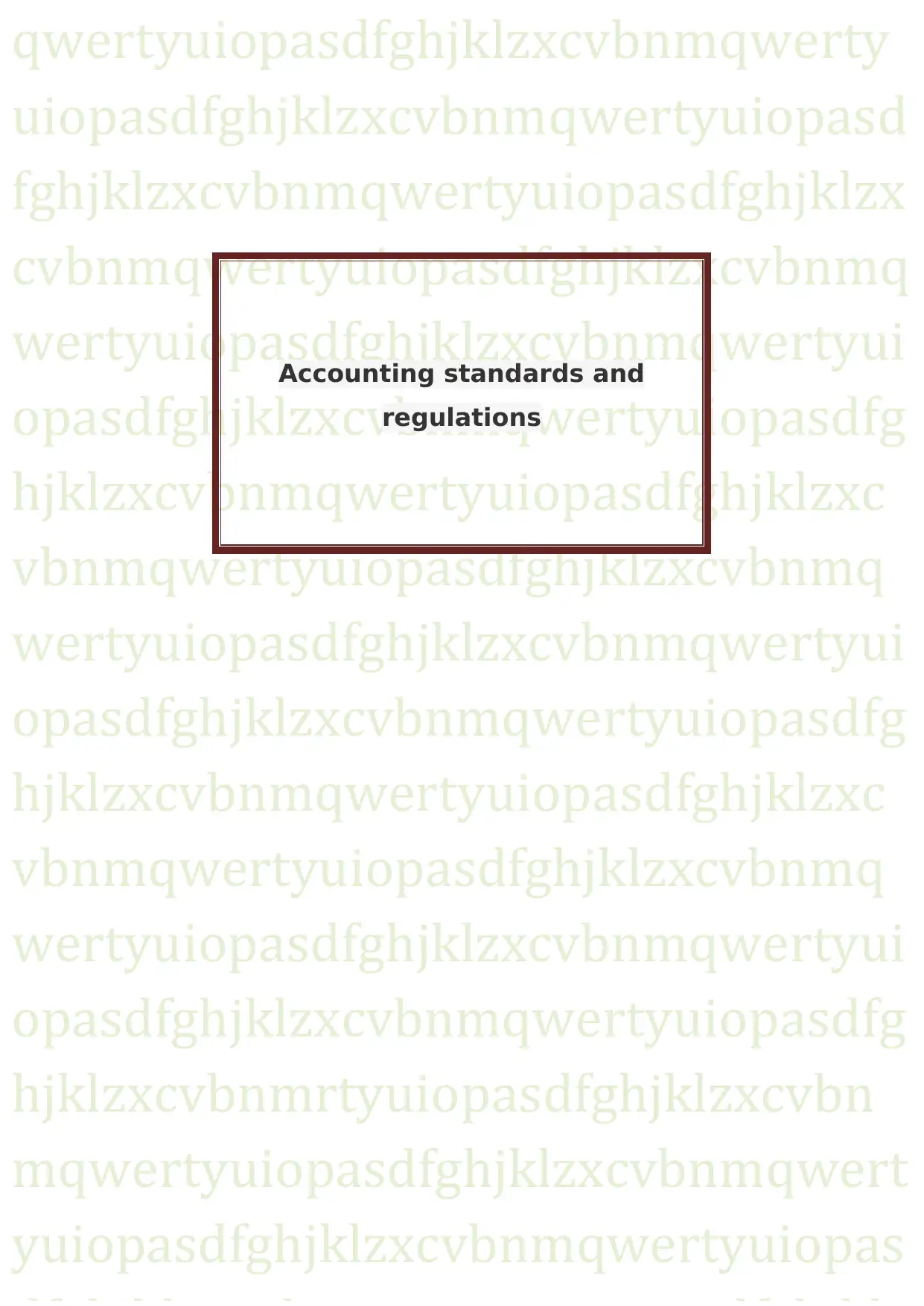
qwertyuiopasdfghjklzxcvbnmqwerty
uiopasdfghjklzxcvbnmqwertyuiopasd
fghjklzxcvbnmqwertyuiopasdfghjklzx
cvbnmqwertyuiopasdfghjklzxcvbnmq
wertyuiopasdfghjklzxcvbnmqwertyui
opasdfghjklzxcvbnmqwertyuiopasdfg
hjklzxcvbnmqwertyuiopasdfghjklzxc
vbnmqwertyuiopasdfghjklzxcvbnmq
wertyuiopasdfghjklzxcvbnmqwertyui
opasdfghjklzxcvbnmqwertyuiopasdfg
hjklzxcvbnmqwertyuiopasdfghjklzxc
vbnmqwertyuiopasdfghjklzxcvbnmq
wertyuiopasdfghjklzxcvbnmqwertyui
opasdfghjklzxcvbnmqwertyuiopasdfg
hjklzxcvbnmrtyuiopasdfghjklzxcvbn
mqwertyuiopasdfghjklzxcvbnmqwert
yuiopasdfghjklzxcvbnmqwertyuiopas
Accounting standards and
regulations
uiopasdfghjklzxcvbnmqwertyuiopasd
fghjklzxcvbnmqwertyuiopasdfghjklzx
cvbnmqwertyuiopasdfghjklzxcvbnmq
wertyuiopasdfghjklzxcvbnmqwertyui
opasdfghjklzxcvbnmqwertyuiopasdfg
hjklzxcvbnmqwertyuiopasdfghjklzxc
vbnmqwertyuiopasdfghjklzxcvbnmq
wertyuiopasdfghjklzxcvbnmqwertyui
opasdfghjklzxcvbnmqwertyuiopasdfg
hjklzxcvbnmqwertyuiopasdfghjklzxc
vbnmqwertyuiopasdfghjklzxcvbnmq
wertyuiopasdfghjklzxcvbnmqwertyui
opasdfghjklzxcvbnmqwertyuiopasdfg
hjklzxcvbnmrtyuiopasdfghjklzxcvbn
mqwertyuiopasdfghjklzxcvbnmqwert
yuiopasdfghjklzxcvbnmqwertyuiopas
Accounting standards and
regulations
Paraphrase This Document
Need a fresh take? Get an instant paraphrase of this document with our AI Paraphraser
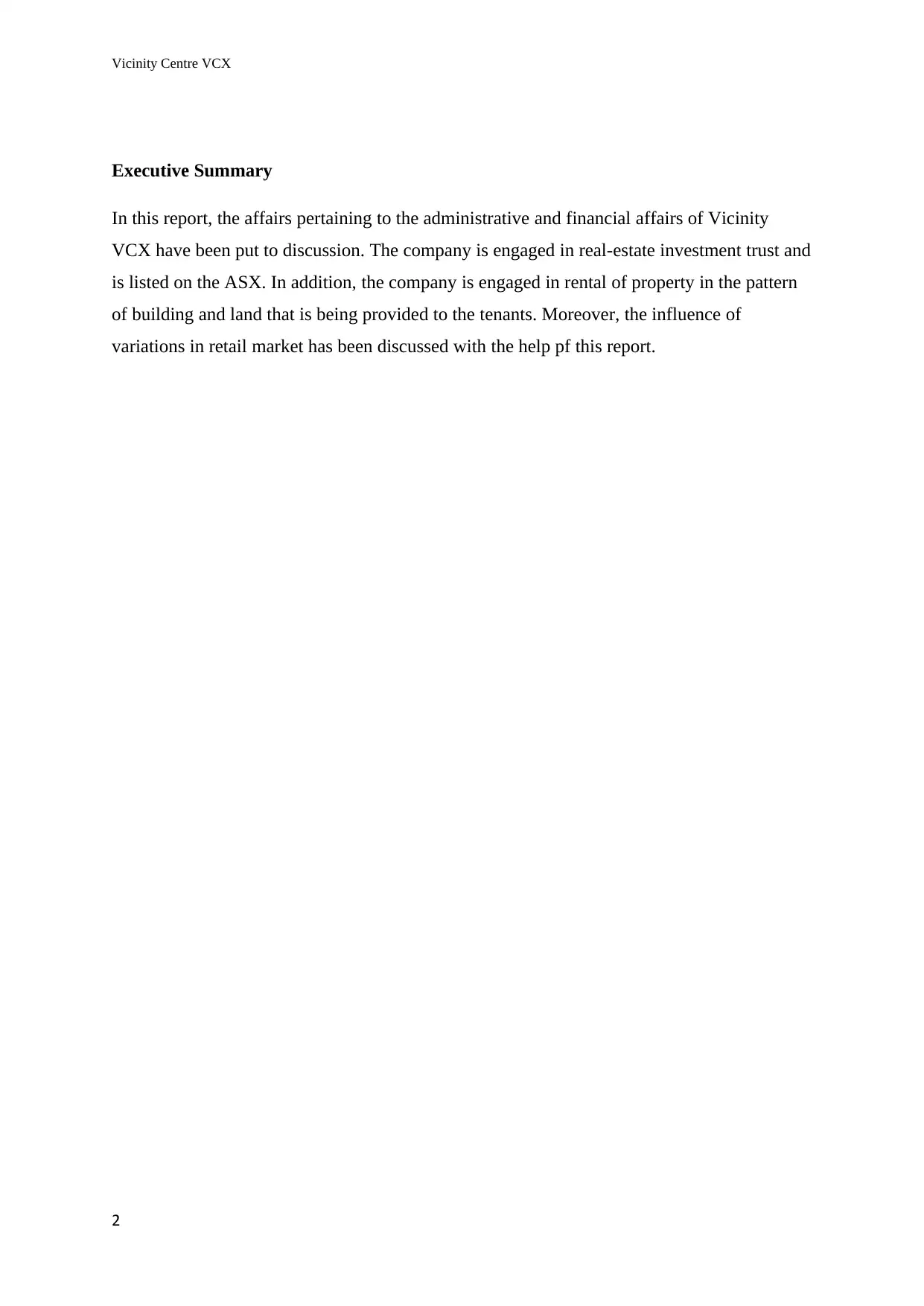
Vicinity Centre VCX
Executive Summary
In this report, the affairs pertaining to the administrative and financial affairs of Vicinity
VCX have been put to discussion. The company is engaged in real-estate investment trust and
is listed on the ASX. In addition, the company is engaged in rental of property in the pattern
of building and land that is being provided to the tenants. Moreover, the influence of
variations in retail market has been discussed with the help pf this report.
2
Executive Summary
In this report, the affairs pertaining to the administrative and financial affairs of Vicinity
VCX have been put to discussion. The company is engaged in real-estate investment trust and
is listed on the ASX. In addition, the company is engaged in rental of property in the pattern
of building and land that is being provided to the tenants. Moreover, the influence of
variations in retail market has been discussed with the help pf this report.
2
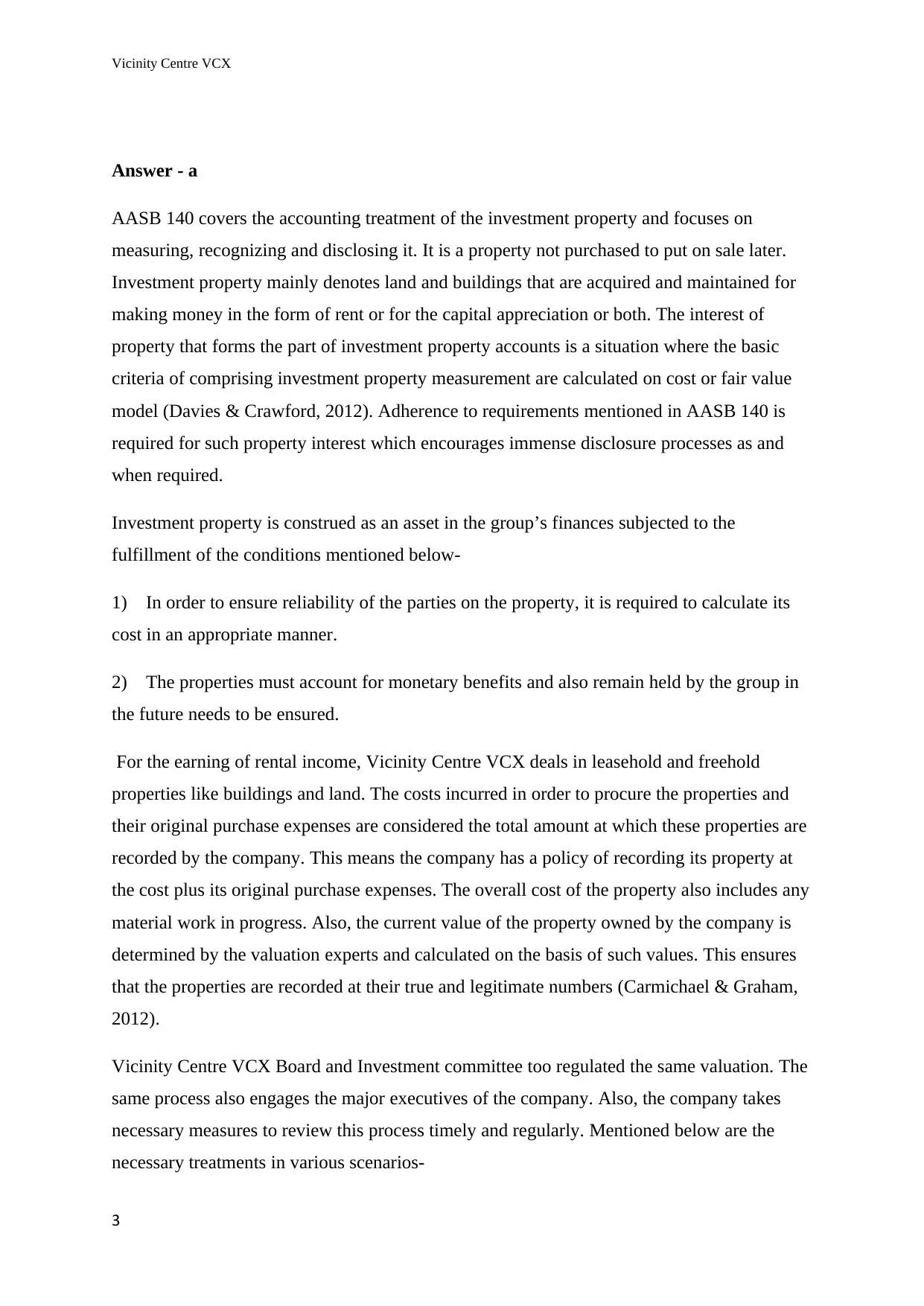
Vicinity Centre VCX
Answer - a
AASB 140 covers the accounting treatment of the investment property and focuses on
measuring, recognizing and disclosing it. It is a property not purchased to put on sale later.
Investment property mainly denotes land and buildings that are acquired and maintained for
making money in the form of rent or for the capital appreciation or both. The interest of
property that forms the part of investment property accounts is a situation where the basic
criteria of comprising investment property measurement are calculated on cost or fair value
model (Davies & Crawford, 2012). Adherence to requirements mentioned in AASB 140 is
required for such property interest which encourages immense disclosure processes as and
when required.
Investment property is construed as an asset in the group’s finances subjected to the
fulfillment of the conditions mentioned below-
1) In order to ensure reliability of the parties on the property, it is required to calculate its
cost in an appropriate manner.
2) The properties must account for monetary benefits and also remain held by the group in
the future needs to be ensured.
For the earning of rental income, Vicinity Centre VCX deals in leasehold and freehold
properties like buildings and land. The costs incurred in order to procure the properties and
their original purchase expenses are considered the total amount at which these properties are
recorded by the company. This means the company has a policy of recording its property at
the cost plus its original purchase expenses. The overall cost of the property also includes any
material work in progress. Also, the current value of the property owned by the company is
determined by the valuation experts and calculated on the basis of such values. This ensures
that the properties are recorded at their true and legitimate numbers (Carmichael & Graham,
2012).
Vicinity Centre VCX Board and Investment committee too regulated the same valuation. The
same process also engages the major executives of the company. Also, the company takes
necessary measures to review this process timely and regularly. Mentioned below are the
necessary treatments in various scenarios-
3
Answer - a
AASB 140 covers the accounting treatment of the investment property and focuses on
measuring, recognizing and disclosing it. It is a property not purchased to put on sale later.
Investment property mainly denotes land and buildings that are acquired and maintained for
making money in the form of rent or for the capital appreciation or both. The interest of
property that forms the part of investment property accounts is a situation where the basic
criteria of comprising investment property measurement are calculated on cost or fair value
model (Davies & Crawford, 2012). Adherence to requirements mentioned in AASB 140 is
required for such property interest which encourages immense disclosure processes as and
when required.
Investment property is construed as an asset in the group’s finances subjected to the
fulfillment of the conditions mentioned below-
1) In order to ensure reliability of the parties on the property, it is required to calculate its
cost in an appropriate manner.
2) The properties must account for monetary benefits and also remain held by the group in
the future needs to be ensured.
For the earning of rental income, Vicinity Centre VCX deals in leasehold and freehold
properties like buildings and land. The costs incurred in order to procure the properties and
their original purchase expenses are considered the total amount at which these properties are
recorded by the company. This means the company has a policy of recording its property at
the cost plus its original purchase expenses. The overall cost of the property also includes any
material work in progress. Also, the current value of the property owned by the company is
determined by the valuation experts and calculated on the basis of such values. This ensures
that the properties are recorded at their true and legitimate numbers (Carmichael & Graham,
2012).
Vicinity Centre VCX Board and Investment committee too regulated the same valuation. The
same process also engages the major executives of the company. Also, the company takes
necessary measures to review this process timely and regularly. Mentioned below are the
necessary treatments in various scenarios-
3
⊘ This is a preview!⊘
Do you want full access?
Subscribe today to unlock all pages.

Trusted by 1+ million students worldwide
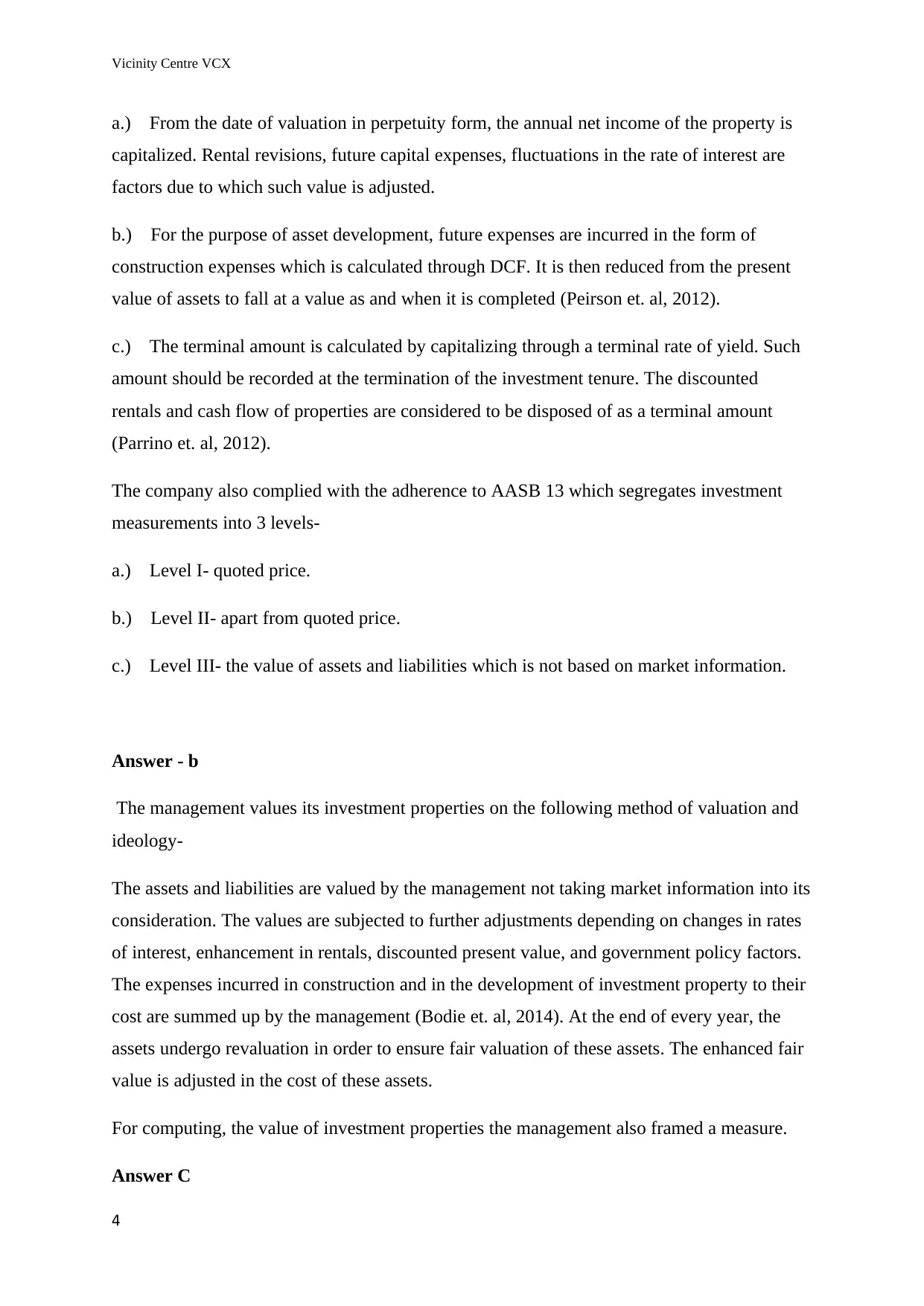
Vicinity Centre VCX
a.) From the date of valuation in perpetuity form, the annual net income of the property is
capitalized. Rental revisions, future capital expenses, fluctuations in the rate of interest are
factors due to which such value is adjusted.
b.) For the purpose of asset development, future expenses are incurred in the form of
construction expenses which is calculated through DCF. It is then reduced from the present
value of assets to fall at a value as and when it is completed (Peirson et. al, 2012).
c.) The terminal amount is calculated by capitalizing through a terminal rate of yield. Such
amount should be recorded at the termination of the investment tenure. The discounted
rentals and cash flow of properties are considered to be disposed of as a terminal amount
(Parrino et. al, 2012).
The company also complied with the adherence to AASB 13 which segregates investment
measurements into 3 levels-
a.) Level I- quoted price.
b.) Level II- apart from quoted price.
c.) Level III- the value of assets and liabilities which is not based on market information.
Answer - b
The management values its investment properties on the following method of valuation and
ideology-
The assets and liabilities are valued by the management not taking market information into its
consideration. The values are subjected to further adjustments depending on changes in rates
of interest, enhancement in rentals, discounted present value, and government policy factors.
The expenses incurred in construction and in the development of investment property to their
cost are summed up by the management (Bodie et. al, 2014). At the end of every year, the
assets undergo revaluation in order to ensure fair valuation of these assets. The enhanced fair
value is adjusted in the cost of these assets.
For computing, the value of investment properties the management also framed a measure.
Answer C
4
a.) From the date of valuation in perpetuity form, the annual net income of the property is
capitalized. Rental revisions, future capital expenses, fluctuations in the rate of interest are
factors due to which such value is adjusted.
b.) For the purpose of asset development, future expenses are incurred in the form of
construction expenses which is calculated through DCF. It is then reduced from the present
value of assets to fall at a value as and when it is completed (Peirson et. al, 2012).
c.) The terminal amount is calculated by capitalizing through a terminal rate of yield. Such
amount should be recorded at the termination of the investment tenure. The discounted
rentals and cash flow of properties are considered to be disposed of as a terminal amount
(Parrino et. al, 2012).
The company also complied with the adherence to AASB 13 which segregates investment
measurements into 3 levels-
a.) Level I- quoted price.
b.) Level II- apart from quoted price.
c.) Level III- the value of assets and liabilities which is not based on market information.
Answer - b
The management values its investment properties on the following method of valuation and
ideology-
The assets and liabilities are valued by the management not taking market information into its
consideration. The values are subjected to further adjustments depending on changes in rates
of interest, enhancement in rentals, discounted present value, and government policy factors.
The expenses incurred in construction and in the development of investment property to their
cost are summed up by the management (Bodie et. al, 2014). At the end of every year, the
assets undergo revaluation in order to ensure fair valuation of these assets. The enhanced fair
value is adjusted in the cost of these assets.
For computing, the value of investment properties the management also framed a measure.
Answer C
4
Paraphrase This Document
Need a fresh take? Get an instant paraphrase of this document with our AI Paraphraser
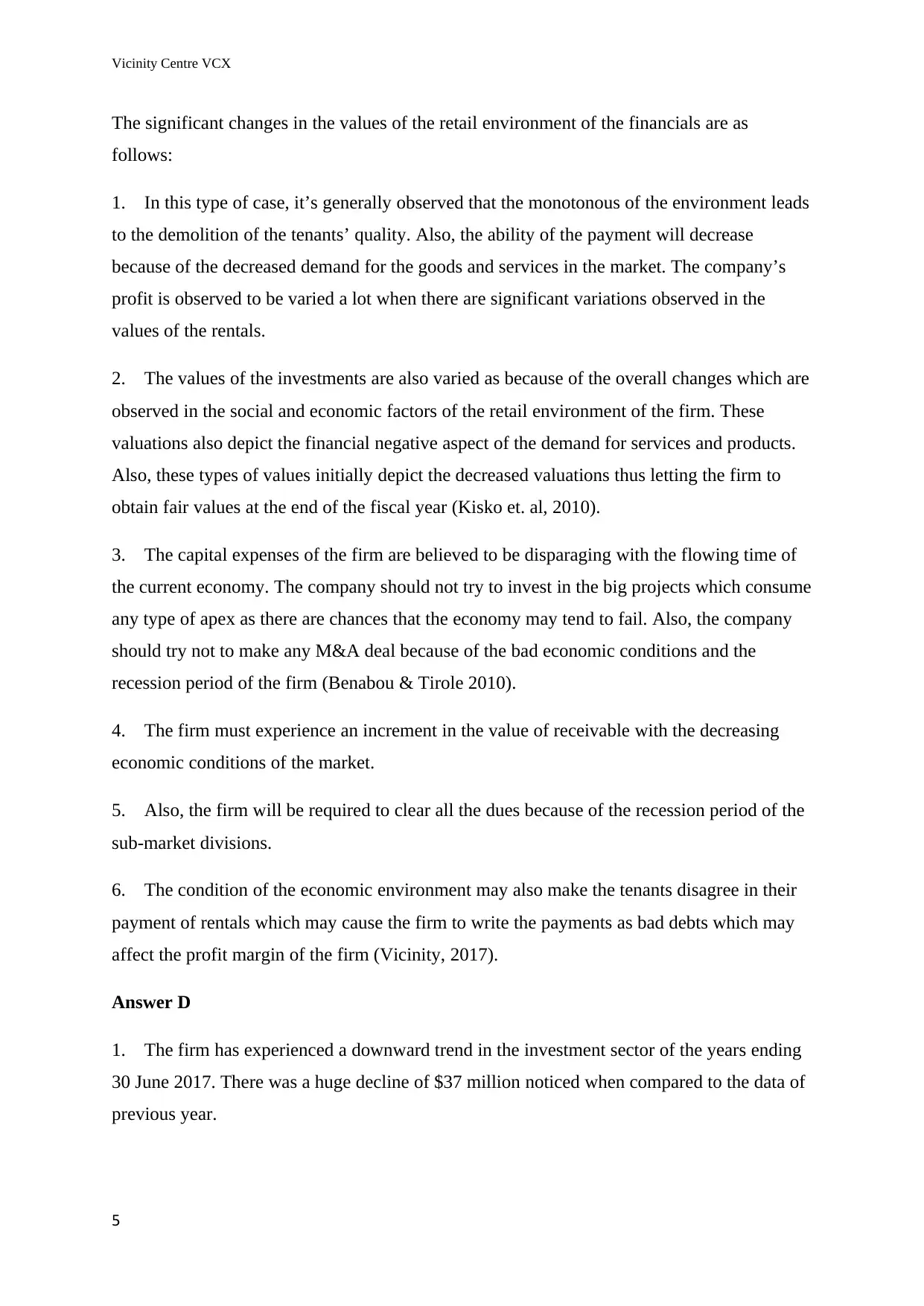
Vicinity Centre VCX
The significant changes in the values of the retail environment of the financials are as
follows:
1. In this type of case, it’s generally observed that the monotonous of the environment leads
to the demolition of the tenants’ quality. Also, the ability of the payment will decrease
because of the decreased demand for the goods and services in the market. The company’s
profit is observed to be varied a lot when there are significant variations observed in the
values of the rentals.
2. The values of the investments are also varied as because of the overall changes which are
observed in the social and economic factors of the retail environment of the firm. These
valuations also depict the financial negative aspect of the demand for services and products.
Also, these types of values initially depict the decreased valuations thus letting the firm to
obtain fair values at the end of the fiscal year (Kisko et. al, 2010).
3. The capital expenses of the firm are believed to be disparaging with the flowing time of
the current economy. The company should not try to invest in the big projects which consume
any type of apex as there are chances that the economy may tend to fail. Also, the company
should try not to make any M&A deal because of the bad economic conditions and the
recession period of the firm (Benabou & Tirole 2010).
4. The firm must experience an increment in the value of receivable with the decreasing
economic conditions of the market.
5. Also, the firm will be required to clear all the dues because of the recession period of the
sub-market divisions.
6. The condition of the economic environment may also make the tenants disagree in their
payment of rentals which may cause the firm to write the payments as bad debts which may
affect the profit margin of the firm (Vicinity, 2017).
Answer D
1. The firm has experienced a downward trend in the investment sector of the years ending
30 June 2017. There was a huge decline of $37 million noticed when compared to the data of
previous year.
5
The significant changes in the values of the retail environment of the financials are as
follows:
1. In this type of case, it’s generally observed that the monotonous of the environment leads
to the demolition of the tenants’ quality. Also, the ability of the payment will decrease
because of the decreased demand for the goods and services in the market. The company’s
profit is observed to be varied a lot when there are significant variations observed in the
values of the rentals.
2. The values of the investments are also varied as because of the overall changes which are
observed in the social and economic factors of the retail environment of the firm. These
valuations also depict the financial negative aspect of the demand for services and products.
Also, these types of values initially depict the decreased valuations thus letting the firm to
obtain fair values at the end of the fiscal year (Kisko et. al, 2010).
3. The capital expenses of the firm are believed to be disparaging with the flowing time of
the current economy. The company should not try to invest in the big projects which consume
any type of apex as there are chances that the economy may tend to fail. Also, the company
should try not to make any M&A deal because of the bad economic conditions and the
recession period of the firm (Benabou & Tirole 2010).
4. The firm must experience an increment in the value of receivable with the decreasing
economic conditions of the market.
5. Also, the firm will be required to clear all the dues because of the recession period of the
sub-market divisions.
6. The condition of the economic environment may also make the tenants disagree in their
payment of rentals which may cause the firm to write the payments as bad debts which may
affect the profit margin of the firm (Vicinity, 2017).
Answer D
1. The firm has experienced a downward trend in the investment sector of the years ending
30 June 2017. There was a huge decline of $37 million noticed when compared to the data of
previous year.
5
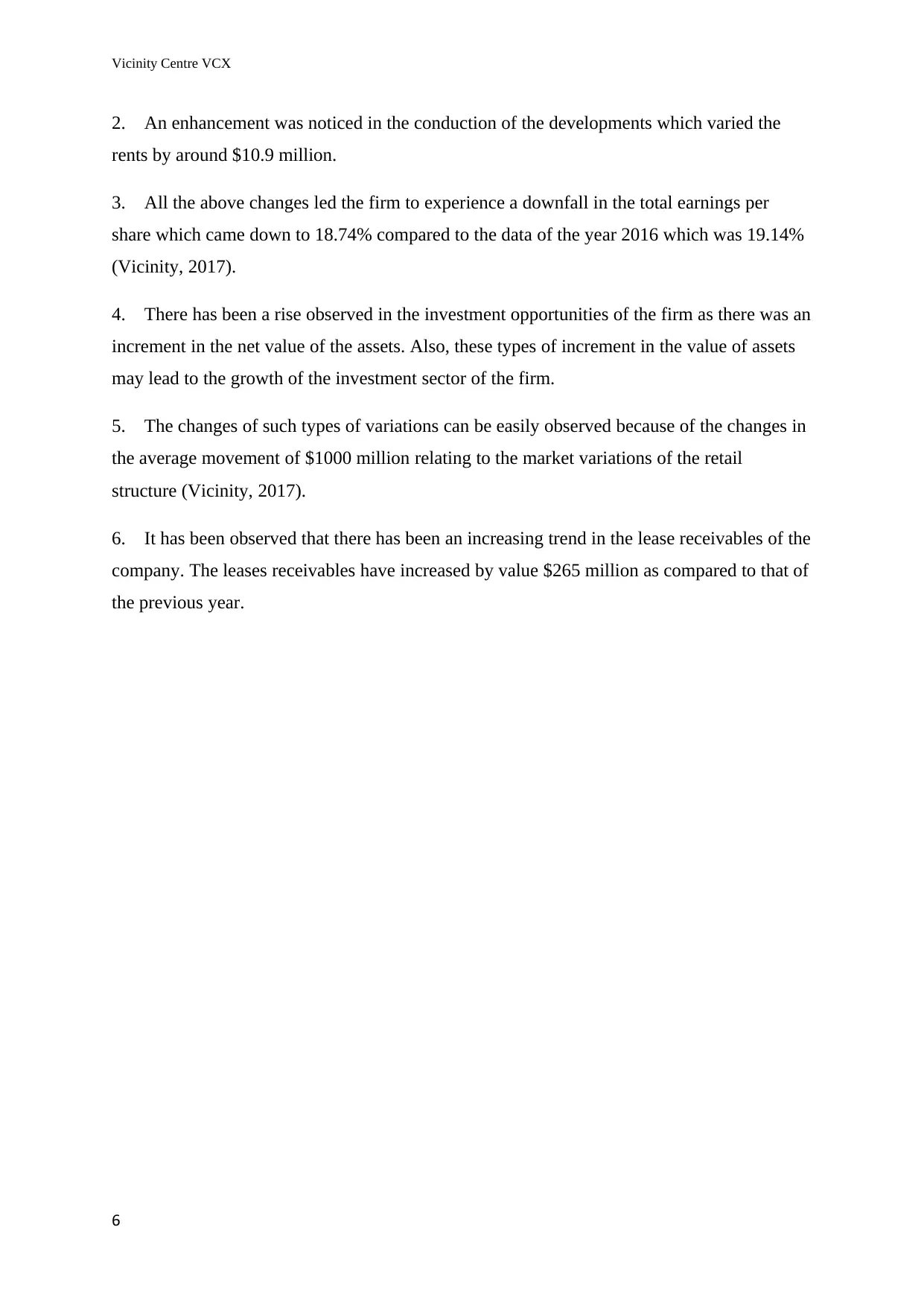
Vicinity Centre VCX
2. An enhancement was noticed in the conduction of the developments which varied the
rents by around $10.9 million.
3. All the above changes led the firm to experience a downfall in the total earnings per
share which came down to 18.74% compared to the data of the year 2016 which was 19.14%
(Vicinity, 2017).
4. There has been a rise observed in the investment opportunities of the firm as there was an
increment in the net value of the assets. Also, these types of increment in the value of assets
may lead to the growth of the investment sector of the firm.
5. The changes of such types of variations can be easily observed because of the changes in
the average movement of $1000 million relating to the market variations of the retail
structure (Vicinity, 2017).
6. It has been observed that there has been an increasing trend in the lease receivables of the
company. The leases receivables have increased by value $265 million as compared to that of
the previous year.
6
2. An enhancement was noticed in the conduction of the developments which varied the
rents by around $10.9 million.
3. All the above changes led the firm to experience a downfall in the total earnings per
share which came down to 18.74% compared to the data of the year 2016 which was 19.14%
(Vicinity, 2017).
4. There has been a rise observed in the investment opportunities of the firm as there was an
increment in the net value of the assets. Also, these types of increment in the value of assets
may lead to the growth of the investment sector of the firm.
5. The changes of such types of variations can be easily observed because of the changes in
the average movement of $1000 million relating to the market variations of the retail
structure (Vicinity, 2017).
6. It has been observed that there has been an increasing trend in the lease receivables of the
company. The leases receivables have increased by value $265 million as compared to that of
the previous year.
6
⊘ This is a preview!⊘
Do you want full access?
Subscribe today to unlock all pages.

Trusted by 1+ million students worldwide
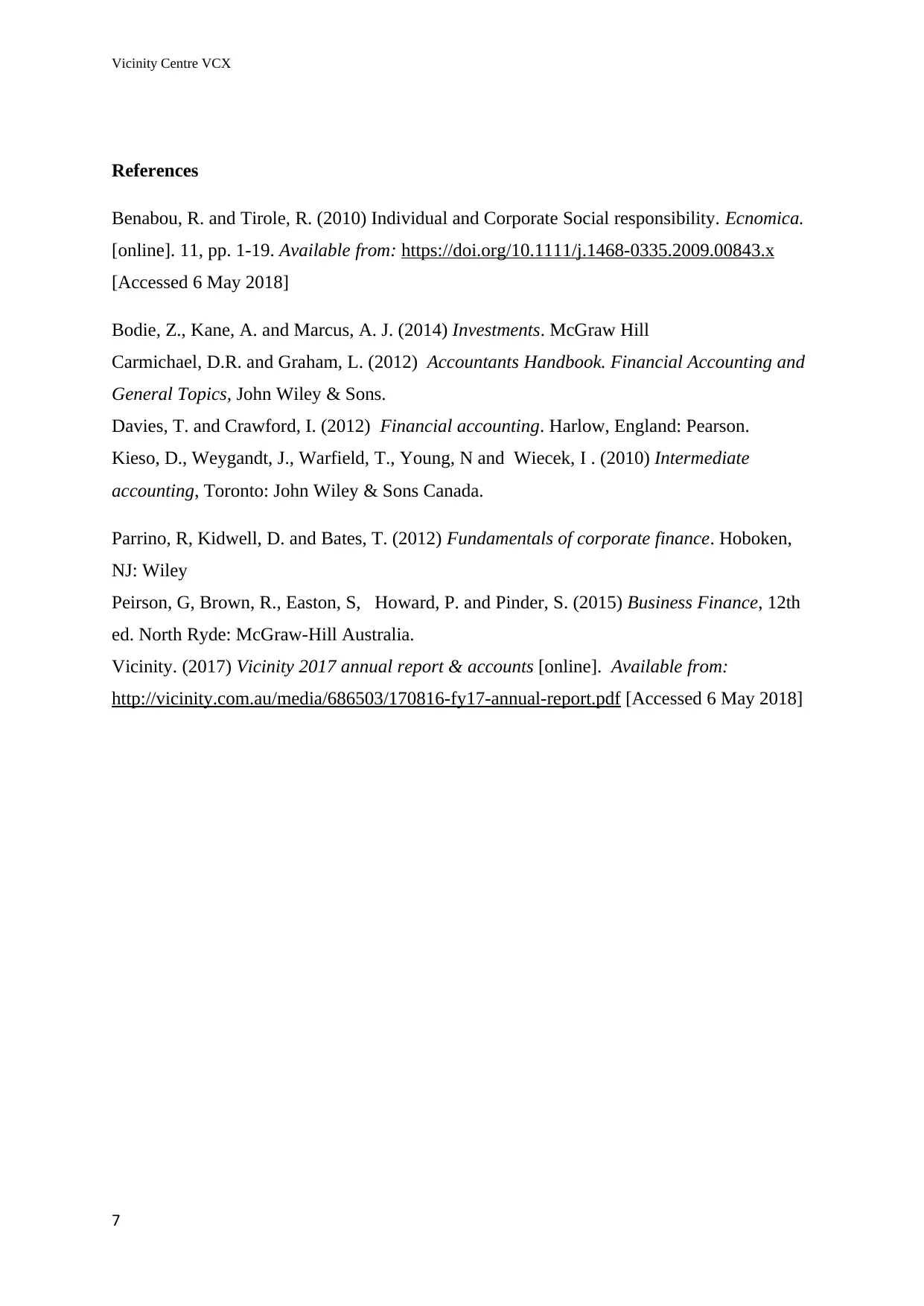
Vicinity Centre VCX
References
Benabou, R. and Tirole, R. (2010) Individual and Corporate Social responsibility. Ecnomica.
[online]. 11, pp. 1-19. Available from: https://doi.org/10.1111/j.1468-0335.2009.00843.x
[Accessed 6 May 2018]
Bodie, Z., Kane, A. and Marcus, A. J. (2014) Investments. McGraw Hill
Carmichael, D.R. and Graham, L. (2012) Accountants Handbook. Financial Accounting and
General Topics, John Wiley & Sons.
Davies, T. and Crawford, I. (2012) Financial accounting. Harlow, England: Pearson.
Kieso, D., Weygandt, J., Warfield, T., Young, N and Wiecek, I . (2010) Intermediate
accounting, Toronto: John Wiley & Sons Canada.
Parrino, R, Kidwell, D. and Bates, T. (2012) Fundamentals of corporate finance. Hoboken,
NJ: Wiley
Peirson, G, Brown, R., Easton, S, Howard, P. and Pinder, S. (2015) Business Finance, 12th
ed. North Ryde: McGraw-Hill Australia.
Vicinity. (2017) Vicinity 2017 annual report & accounts [online]. Available from:
http://vicinity.com.au/media/686503/170816-fy17-annual-report.pdf [Accessed 6 May 2018]
7
References
Benabou, R. and Tirole, R. (2010) Individual and Corporate Social responsibility. Ecnomica.
[online]. 11, pp. 1-19. Available from: https://doi.org/10.1111/j.1468-0335.2009.00843.x
[Accessed 6 May 2018]
Bodie, Z., Kane, A. and Marcus, A. J. (2014) Investments. McGraw Hill
Carmichael, D.R. and Graham, L. (2012) Accountants Handbook. Financial Accounting and
General Topics, John Wiley & Sons.
Davies, T. and Crawford, I. (2012) Financial accounting. Harlow, England: Pearson.
Kieso, D., Weygandt, J., Warfield, T., Young, N and Wiecek, I . (2010) Intermediate
accounting, Toronto: John Wiley & Sons Canada.
Parrino, R, Kidwell, D. and Bates, T. (2012) Fundamentals of corporate finance. Hoboken,
NJ: Wiley
Peirson, G, Brown, R., Easton, S, Howard, P. and Pinder, S. (2015) Business Finance, 12th
ed. North Ryde: McGraw-Hill Australia.
Vicinity. (2017) Vicinity 2017 annual report & accounts [online]. Available from:
http://vicinity.com.au/media/686503/170816-fy17-annual-report.pdf [Accessed 6 May 2018]
7
1 out of 7
Related Documents
Your All-in-One AI-Powered Toolkit for Academic Success.
+13062052269
info@desklib.com
Available 24*7 on WhatsApp / Email
![[object Object]](/_next/static/media/star-bottom.7253800d.svg)
Unlock your academic potential
Copyright © 2020–2025 A2Z Services. All Rights Reserved. Developed and managed by ZUCOL.





